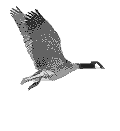

 |
 Inner Wing (The arm and the secondary feathers) The movements of the wing arm and secondary wing feathers are mainly in the vertical plane and provide a significant proportion of the wings lift. On the down stroke the wing is forcibly pulled down and the air below it is forced down (Fig. 1 through Fig. 8). This in return creates an upward reaction on the bird. At the same time this portion on the wing acts as an airfoil providing additional lift. Wing End (The Hand and the primary feathers) The primary feathers move downward and slightly forward, with the primaries overlapping to form an airtight surface. Thrust is provided at the wing tip by the outer primary feathers which twist as they are forced through the air. The design of the primary feathers bends the trailing edge of each feather upward so each feather acts as an airfoil pushing the bird forward (Fig. 1 through Fig. 5). As the wing stroke continues (Fig. 4 through Fig. 8) the leading edge twists increasingly downward from the base to the tip such that the wing becomes propeller shaped (Fig. 5 shows the ripple on the right wing) with more twisting to the rear. This ripple moves from the center to the tip of the wing. This results in air being driven backwards and the bird being moved forward. |
 Inner Wing (The arm and the secondary feathers) During the up stroke the inner wing is rotated about the shoulder to increase it's angle of attack. This allows lift to be generated even though the movement of the wing is upwards (Fig. 1 through Fig. 5). Wing End (The Hand and the primary feathers) As the wing continues it's movement in the upstroke (Fig. 1 through Fig. 5) the Wing End is partly folded and the primary feathers twist open allowing air to pass between the spaces to minimize the airs resistance. The bend of the feathers in (Fig. 3) suggests the air is moving down and may be contributing the the lift by the wing end in the up stroke as well. |
NORMAL LEVEL FLIGHT.
The air forced off the wing results in a continuous air vortex being generated behind the bird. What is most supprizing is the strength of the vortex in the up stroke. See the additional web links for more information about wing movements and air vottexes.
- Does the gap between the last 4 flights help these flights to act as individual propellers during the down stroke?
- Does the same gap assist in the up stroke by further reducing the resistance to lifting the wing?